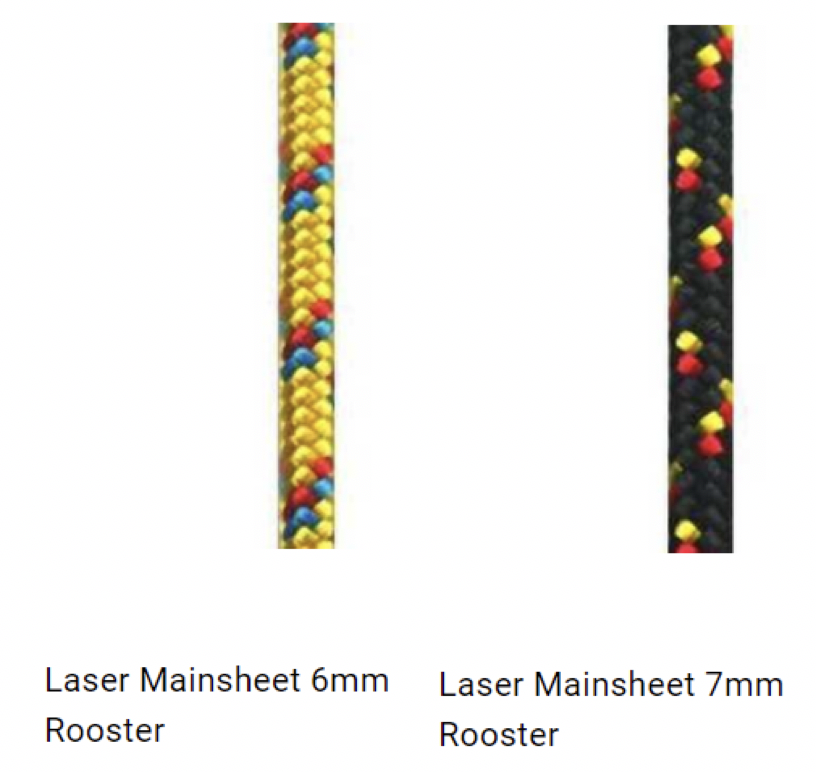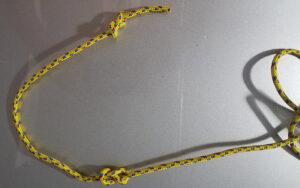
Does your mainsheet get knotted up at the most inconvenient time? Do you find it difficult to keep your boom out while going downwind? Do your feet get tangled up in your mainsheet while you are trying to tack? Here are some ideas that might help.
Mainsheet selection
First, repurpose or throw away your old, fuzzy, heavy mainsheet. Replace it with either a 6- or 7-millimeter Rooster or equivalent mainsheet. The 6-millimeter Rooster yellow is used by most of the World Cup and Olympians in all conditions. It is perfect for light winds and will allow you to keep your boom out while going downwind in light winds. Heavier mainsheets tend to pull your boom in and make the sail collapse in lighter wind.

Rooster Mainsheet 6mm and 7mm
For heavier wind conditions, I like the 7-millimeter Rooster black because it puts less strain on my hands. Your mainsheet should be at least 44 feet long. DO NOT CUT IT SHORTER!
Mainsheet preparation and installation
Put your mainsheet in the washing machine and run it through a cycle or two to wash the shine off the mainsheet. This will make it less slippery and easier to grip. Al Sargent goes a few steps further and suggests, “When I first get a Rooster mainsheet, I like to wash it on extra hot to get out all the slippery coatings. Then I like to run it through sandpaper, maybe 100 grit, a few times so that it's slightly fuzzy and thus easier to grip. This extends the wind range in which I can use the thinner, yellow 6mm Rooster mainsheet.” He also suggests tossing your mainsheet into the wash regularly to ensure that it's free of salt or grime that can make it stiffer.
I like to put two figure-eight knots about a foot apart at the cockpit end of the mainsheet. The knots prevent the mainsheet from running out through the mainsheet block. Not having the mainsheet attached allows me to throw the trailing end of the mainsheet into the water and drag it behind the boat to remove twists. I can also adjust the second knot to shorten the mainsheet in very high winds to prevent me from accidently letting out too much mainsheet which can cause an immediate death roll. When the wind gets up beyond 15 knots, I generally move the second knot up the mainsheet so that there is at least 3 feet between the knots. When the wind is light, I move the knot back down the mainsheet so that there is about 1 foot between the knots.

As an alternative, some people like to attach their mainsheet to the stern end of their hiking strap. There are some advantages and disadvantages to this approach. I will leave it up to you which system you prefer.
Starting
In between races and/or at the beginning of each starting sequence, get all of the kinks and twists out of your mainsheet. Carefully stack your mainsheet slack into the back of your cockpit. By doing this you will at least have one time during the race when your mainsheet is perfectly organized.
Upwind
You should be using your mainsheet to control your sail shape. This is a dynamic process. You are continually sheeting in and out, even if it is only an inch or two. Consequently, don’t cleat your mainsheet into the deck cleats. If fact, get rid of the deck cleats. The vast majority of the top sailors don’t use them at all.
Tacking
Before you begin a tack, make sure that you free up an arm’s length of mainsheet and lay it on the deck or on your lap. This will ensure that you are not stepping on or getting tangled in the mainsheet during your tack. Even better, free up an arm’s length of mainsheet after every tack. This will ensure that you are always ready to tack at a moment’s notice.

Clearing the mainsheet after a tacking in a Laser ILCA dinghy
Windward Mark Rounding
Free up a couple of arm lengths of mainsheet and lay them on the deck as you approach the windward mark. As you make the turn, raise your sheet hand with sheet in it high above your head and then drive your hand with the sheet toward the mainsheet block and then let the rest of the mainsheet slide through your hand. Do not loose contact with the mainsheet.
Downwind
Downwind sail trimming is also a dynamic process. You should be constantly trimming to find the precise by-the-lee angle that gives your sail the most power. This is constantly changing as your boat speeds up or slows down and as you change your sailing angle to achieve best VMG.
Leeward Mark Rounding
This is where you mess up your mainsheet the most. As you round the leeward mark you need to sheet in just as fast as you possibly can at the appropriate moment. You can practice building your speed and managing where your mainsheet lands in the cockpit on dry land in your boat with a partner. Start by sheeting in a fully extended sail and boom in slow motion to ensure that your hands and arms are moving correctly. Slowly build up your speed while maintaining correct form. With just a few days of practice you will increase your speed and improve your mainsheet management significantly.
Mainsheet Storage
When you put your boat away, don’t coil up and tie up your mainsheet. Or worse yet, don’t just pile it up into a tangled mess in your cockpit. Instead, lay it out flat on your deck from bow to stern and let it dry straight, with no kinks or knots. I maintain that if you let your mainsheet live most of its life straight, untwisted and untangled that it will be more likely to stay that way during a race. So far, I’ve had pretty good results with this approach.
If you have to coil up your mainsheet, Al Sargent and Tom Vollbrecht both recommend using a butterfly coil. This a technique that rock climbers use to coil up their ropes so they don't have kinks: https://www.petzl.com/US/en/Sport/How-to-coil-the-rope-?ActivityName=Multi-pitch-climbing
Good luck and sail fast, UNTANGLED!